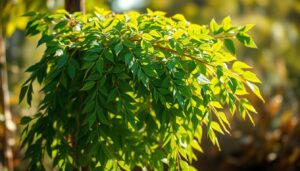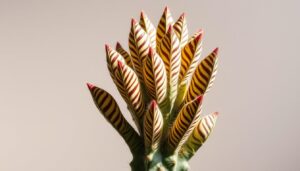Introduction
Cradling the delicate leaves of a baby rubber plant in your hands, you embark on a journey of botanical stewardship, where each tender touch and thoughtful gesture fosters growth and vitality. The baby rubber plant, scientifically known as Peperomia obtusifolia, is a charming addition to any indoor garden, with its glossy foliage and compact size. However, like any infant, it requires gentle care and attention to thrive.
In this nurturing guide, we delve into the art of baby rubber plant care, exploring the essential elements that contribute to its flourishing presence in your home or office space. From lighting to watering, soil to propagation, we uncover the secrets to cultivating a verdant haven where your baby rubber plant can thrive and flourish.
So, let us embark on this botanical journey together, as we learn to nurture and cherish our baby rubber plants, watching them grow from delicate saplings into robust, resilient specimens, enriching our lives with their beauty and vitality.
Illuminating Insights: Light Requirements
In the nurturing journey of baby rubber plant care, light stands as the radiant cornerstone upon which its growth and vitality hinge. Understanding and providing the optimal lighting conditions for your baby rubber plant ensures its photosynthetic prowess and overall well-being. Let’s shed some light on this crucial aspect:
Light Intensity:
Baby rubber plants thrive in bright, indirect light. Placing them near a north or east-facing window where they receive gentle, filtered sunlight is ideal. Direct exposure to intense sunlight can scorch their leaves, while too little light may result in leggy growth and diminished vibrancy.
Duration of Light Exposure:
Consistency is key when it comes to light exposure. Aim for 6-8 hours of indirect sunlight daily. Rotate the plant occasionally to promote even growth and prevent one-sided leaning towards the light source.
Supplemental Lighting:
In spaces with limited natural light, supplementing with artificial grow lights can provide the necessary luminance for optimal growth. LED grow lights, positioned a few feet above the plant, mimic natural sunlight and can be programmed to deliver the ideal light spectrum for photosynthesis.
Signs of Light Stress:
Observing your baby rubber plant for signs of light stress is crucial for maintaining its health. Pale or yellowing leaves, along with leggy growth, indicate insufficient light, while scorched or browned foliage suggests excessive light exposure.
Adjusting Light Levels:
Monitor your plant’s response to its current lighting conditions and adjust placement accordingly. Moving it further from or closer to the light source can help strike the perfect balance and prevent light-related issues.
Winter Considerations:
During the winter months, when daylight hours are shorter, supplementing natural light with artificial lighting becomes especially important. Be mindful of drafts from windows during colder periods, as baby rubber plants are sensitive to temperature fluctuations.
Quenching Thirst: Watering Guidelines
In the delicate dance of baby rubber plant care, mastering the art of watering is akin to providing life’s essential elixir, ensuring vigor and vitality in every drop. However, striking the right balance between hydration and moderation is paramount to prevent the perils of overwatering or dehydration. Let’s delve into the watering guidelines for nurturing your baby rubber plant:
Frequency of Watering:
Baby rubber plants prefer slightly moist soil but are susceptible to root rot if overwatered. As a general rule, water your plant when the top inch of the soil feels dry to the touch. Depending on environmental conditions such as temperature and humidity, this typically translates to watering every 7-10 days.
Watering Technique:
When watering your baby rubber plant, aim for thorough yet gentle hydration. Avoid drenching the soil, as excess water can lead to stagnant moisture around the roots. Instead, water the plant until moisture begins to seep through the drainage holes at the bottom of the pot, ensuring adequate hydration without waterlogging.
Soil Moisture Monitoring:
Regularly assess the moisture level of the soil to prevent overwatering or underwatering. Inserting a finger into the soil or using a moisture meter can help gauge when watering is necessary. Remember, it’s better to err on the side of underwatering than to saturate the soil excessively.
Seasonal Adjustments:
Adjust your watering frequency according to seasonal changes and environmental conditions. Baby rubber plants experience slower growth during the winter months, necessitating reduced watering to prevent waterlogged soil. Conversely, increased watering may be required during the warmer months to accommodate heightened growth and evaporation rates.
Water Quality:
Opt for room temperature, filtered water to avoid subjecting your baby rubber plant to the harsh effects of chlorine or fluoride present in tap water. Allow water to sit for 24 hours before use to dissipate any residual chemicals and ensure a gentler watering experience for your plant.
Drainage Considerations:
Ensure proper drainage by using a well-draining potting mix and a container with drainage holes. Excess water should be able to escape freely, preventing waterlogged soil and potential root suffocation.
Nutrient Nourishment: Feeding Schedule
In the verdant tapestry of baby rubber plant care, nourishing your botanical companion with essential nutrients is akin to providing sustenance for its growth and vitality. While baby rubber plants are relatively low-maintenance, they benefit from periodic fertilization to replenish soil nutrients and support robust foliage development. Let’s explore a comprehensive feeding schedule to keep your baby rubber plant thriving:
Choosing the Right Fertilizer:
Selecting a balanced, water-soluble fertilizer with a formulation such as 10-10-10 or 20-20-20 ensures a well-rounded nutrient profile for your baby rubber plant. Avoid fertilizers high in nitrogen, as they can promote excessive foliage growth at the expense of overall plant health.
Frequency of Fertilization:
During the active growing season in spring and summer, fertilize your baby rubber plant every 4-6 weeks to coincide with its increased metabolic demands. Reduce fertilization frequency to every 8-12 weeks during the dormant winter months when growth slows.
Dilution Ratio:
When preparing fertilizer solutions, adhere to the dilution ratio recommended on the product label. Overfertilization can lead to salt buildup in the soil, causing root damage and nutrient imbalances. Diluting the fertilizer appropriately ensures gentle yet effective nourishment for your plant.
Application Method:
Apply fertilizer to moist soil, as dry soil may result in fertilizer burn. Water the plant lightly before fertilizing to facilitate nutrient absorption and minimize stress on the roots. Pour the diluted fertilizer solution evenly around the base of the plant, avoiding direct contact with foliage.
Organic Alternatives:
For those inclined towards organic gardening practices, organic fertilizers such as compost tea or diluted fish emulsion offer natural sources of nutrients without synthetic additives. These alternatives provide a gentle yet effective means of fortifying soil fertility and supporting plant growth.
Monitoring Plant Response:
Observe your baby rubber plant’s response to fertilization, ensuring it remains vibrant and healthy. Signs of overfertilization include leaf discoloration, leaf drop, or stunted growth. Adjust the fertilization regimen accordingly to maintain a harmonious balance of nutrients.
Pruning and Propagation: Cultivating Generational Growth
In the lifecycle of a baby rubber plant, pruning and propagation emerge as transformative practices, shaping its form and fostering generational continuity. These horticultural techniques not only rejuvenate the plant but also offer opportunities for expansion and sharing its verdant beauty with others. Let’s delve into the art of pruning and propagation to cultivate generational growth:
Pruning Essentials:
Pruning plays a pivotal role in maintaining the health and aesthetic appeal of your baby rubber plant. Regular removal of dead or yellowing leaves promotes air circulation and prevents the spread of disease. Use sterilized pruning shears to make clean cuts, minimizing the risk of infection.
Targeted Pruning Techniques:
Identify areas of the plant requiring attention, such as leggy growth or overcrowded foliage clusters. Trim back excessive growth to encourage bushier, more compact growth habits. Focus on shaping the plant according to your aesthetic preferences while preserving its natural form.
Propagation Methods:
Propagating baby rubber plants offers an exciting opportunity to expand your botanical collection or share the gift of greenery with friends and family. Two primary propagation methods, stem cuttings and leaf cuttings, enable the creation of new plants from existing specimens.
Stem Cutting Propagation:
Select a healthy stem segment with several leaves intact. Using sharp, sterile scissors, make a clean cut just below a leaf node. Remove the lower leaves to expose the nodes, which will facilitate root development. Place the cutting in moistened potting mix and keep it in a warm, humid environment until roots emerge.
Leaf Cutting Propagation:
Choose a mature, healthy leaf and gently detach it from the stem, ensuring a clean break. Allow the leaf to callus over for a day to prevent rotting. Plant the leaf in a shallow tray filled with moistened soil or perlite, positioning it horizontally with the petiole buried slightly in the substrate. Keep the cutting consistently moist until new plantlets emerge from the base of the leaf.
Caring for Propagated Offshoots:
Once roots or plantlets develop, transplant them into individual pots filled with well-draining potting mix. Provide optimal growing conditions, including bright, indirect light and consistent moisture, to facilitate establishment and growth.
Conclusion: Cultivating a Verdant Legacy
As we conclude our exploration of baby rubber plant care, we reflect on the profound relationship forged between caregiver and botanical companion—a bond nurtured through attentive stewardship and shared growth. Throughout this journey, we have delved into the intricacies of light, water, nutrients, pruning, and propagation, uncovering the nuanced artistry inherent in tending to these resilient yet delicate beings.
In our quest to create verdant sanctuaries within our homes and workplaces, we have discovered that the act of nurturing extends beyond mere cultivation; it is an expression of reverence for the interconnectedness of life and a celebration of the beauty inherent in every leaf and stem. Through the gentle cadence of watering, the meticulous pruning of foliage, and the propagation of new life, we honor the legacy of our baby rubber plants, each generation bearing witness to the enduring cycle of growth and renewal.
As stewards of these botanical treasures, we embrace the responsibility to cultivate not only lush foliage but also a sense of harmony and vitality within our living spaces. In doing so, we foster environments where life flourishes, where the vibrancy of nature permeates every corner, and where the legacy of our care resonates for generations to come.
So, let us continue to tend to our baby rubber plants with love and dedication, nurturing their growth and cherishing the beauty they bring into our lives. For in their verdant embrace, we find solace, inspiration, and a timeless reminder of the wondrous interconnectedness of all living things.
Thank you for your visit to our Site, if you are nearby stop and see us at The Landscape Connection.





Pingback: Rubber Plant, A Bold, Low-Maintenance Houseplant That Adds Instant Elegance